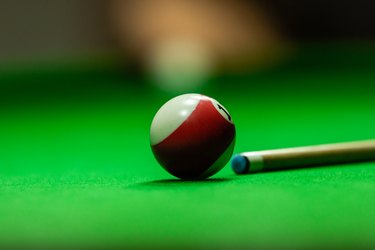
Since 1990, the importation of ivory has been banned in countries around the world with the exception of Japan, the largest domestic ivory market in existence. Once used as an enhancement to cutlery, bone has replaced ivory, and restoring bone-handled cutlery once it starts to lose its patina is a household chore that is easy and effective. Both ivory and bone, whether used in cutlery or sculpture, are maintained with a gentle dusting, but an occasional deeper cleaning is simply a matter of soap and water. Unlike bone, ivory is very reactive to its environment and must be handled with care.
Keeping Ivory Items Clean
Video of the Day
The most destructive environmental causes of discoloration of ivory are humidity and temperature. When the humidity is too low, ivory cracks and shrinks. When it is too high, ivory swells or warps. Temperature fluctuations also cause shrinkage or expansion, especially in items that are thinly carved.
Video of the Day
Ivory is porous and stains easily. Avoid oils and other colored materials when storing ivory and do not use general cleaning substances when maintaining the items. Wearing cotton gloves to create a barrier between hand oils and the ivory, gently dust the pieces and then wipe them with a thin coat of mineral oil. Remove the oil with a soft cloth or brush until it's oil-free and return the item to its display case.
This should be done on an annual basis to restore any moisture that has been lost. For badly dehydrated ivory, apply the mineral oil, wrap the item in a soft cloth and let it sit overnight before thoroughly wiping the piece clean.
Restoring Bone-Handled Cutlery
Frequent use of bone-handled cutlery is one of the best ways to keep it clean. The bone is most likely bovine, with giraffe and camel bone used occasionally. Never wash the cutlery in a dishwasher, as the heat can destroy the composition of the bone. Quickly soak the cutlery in lukewarm, soapy water using a medium that has no citrus. Hot water may discolor the bone. Wipe away the food particles, rinse and dry immediately with a soft cloth before returning the cutlery to its storage cabinet.
If the bone handles on the cutlery have started to darken, consider the color to be part of the ageing process. Cleaning bone-handled cutlery, especially if portions are silver, is a two-step process. Cover the bone handle in cling film and then use a nonabrasive silver cleaning paste to clean the silver. Wipe it dry before moving on to the bone handle.
Restoring Bone-Handled Knives
A beautifully carved, bone-handled pocketknife is a prized possession. Whether intricately carved or simply displaying the elegance of the bone, pocket and hunting knives need care, especially after a hunting expedition. Made from bovine or stag, the handle often becomes dehydrated, and mineral oil is best for restoring bone-handled knives.
First, clean the knife completely, wiping away any detritus and dust. Then, fill a glass with mineral oil, submerge the handle into the oil and let it sit, preferably overnight. The oil seeps into the pores of the bone, hydrating it. In the morning, remove the knife and wipe it with a soft cloth until there is no longer an oil sheen. Finishing it off with a coating of Renaissance Wax keeps in the moisture. If the bone handle is a very light color, the oil may darken it. Test the process on a small segment of the handle first.
- Blade Magazine: Bone Handle Knives: Bone in the USA!
- Smithsonian Museum Conservation Institute: The Care and Handling of Ivory Objects
- Grapevine Birmingham: Ultimate Guide to Cleaning Your Antique Ivory Pieces
- International Knife Collectors Association: Caring For Stag/Bone Handles
- American Foodie Abroad: Silver Fish